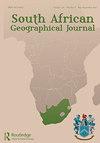Trend analysis of long-term rainfall and temperature data for Ethiopia
IF 1.4
4区 社会学
Q3 GEOGRAPHY
引用次数: 18
Abstract
ABSTRACT Trend analysis for the long-term average temperature and rainfall of Ethiopia during 1901 to 2015 has been performed to understand the pattern of these important meteorological features under climate change. The rainfall characterizations viz., precipitation concentration index (PCI), seasonality index (SI), rainfall anomaly index (RAI) and departure analysis of rainfall (DAR) have been calculated and interpreted. The annual rainfall recorded for the whole period was 816.3 ± 90.82 mm/year. During kiremt (long rainy) season, maximum seasonal rainfall of 453.2 mm were recorded while, its minimum value (39.6 mm) were received in bega (dry) season, respectively. The analysis of probability distribution for the time series data showed slightly positive skewness and kurtosis in monthly, seasonal and annual rainfall from the normal distribution. The results of Modified Mann–Kendall trend analysis for average temperature revealed a significant increasing trend from 1961 to 2015. Conversely, dry season (bega) rainfall, showed an increasing trend while kiremt season rainfall with decreasing trend for the period of 1901–2015. However, annual and other seasonal rainfall did not show any statistically significant trend. Study concludes that there is an increase in the average temperature in Ethiopia but, it constitutes a high degree of stability in rainfall rate and distribution.埃塞俄比亚长期降雨和温度数据趋势分析
本文对埃塞俄比亚1901 - 2015年的长期平均气温和降雨量进行了趋势分析,以了解气候变化下这些重要气象特征的变化规律。对降水特征,即降水浓度指数(PCI)、季节性指数(SI)、降水异常指数(RAI)和降水偏离分析(DAR)进行了计算和解释。全年降雨量为816.3±90.82 mm/年。长雨季节最大降水量为453.2 mm,枯雨季节最小降水量为39.6 mm。对时间序列数据的概率分布分析表明,月、季、年降雨量的偏态和峰度与正态分布有轻微的正相关。修正Mann-Kendall趋势分析结果显示,1961 ~ 2015年平均气温呈显著上升趋势。相反,1901—2015年旱季降水呈增加趋势,旱季降水呈减少趋势。然而,年降雨量和其他季节降雨量在统计上没有显著的变化趋势。研究得出的结论是,埃塞俄比亚的平均气温有所上升,但这构成了降雨率和分布的高度稳定。
本文章由计算机程序翻译,如有差异,请以英文原文为准。
求助全文
约1分钟内获得全文
求助全文
来源期刊

South African Geographical Journal
GEOGRAPHY-
CiteScore
3.40
自引率
7.10%
发文量
25
期刊介绍:
The South African Geographical Journal was founded in 1917 and is the flagship journal of the Society of South African Geographers. The journal aims at using southern Africa as a region from, and through, which to communicate geographic knowledge and to engage with issues and themes relevant to the discipline. The journal is a forum for papers of a high academic quality and welcomes papers dealing with philosophical and methodological issues and topics of an international scope that are significant for the region and the African continent, including: Climate change Environmental studies Development Governance and policy Physical and urban Geography Human Geography Sustainability Tourism GIS and remote sensing
 求助内容:
求助内容: 应助结果提醒方式:
应助结果提醒方式:


